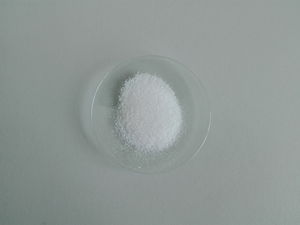Glycine
 Glycine on a watch glass
| |
| Names | |
|---|---|
| IUPAC name
Aminoethanoic acid
| |
| Preferred IUPAC name
Aminoethanoic acid | |
| Other names
2-Aminoacetic acid
Glycocoll | |
| Properties | |
| C2H5NO2 NH2-CH2-COOH | |
| Molar mass | 75.07 g/mol |
| Appearance | White solid |
| Odor | Odorless |
| Density | 1.60 g/cm3 |
| Melting point | 233–240 °C (451–464 °F; 506–513 K) (decomposition) |
| Boiling point | Decomposes |
| 24.99 g/100 ml (25 °C) 39.1 g/100 ml (50 °C) 54.4 g/100 ml (75 °C) 67.2 g/100 ml (100 °C)[1] | |
| Solubility | Soluble in pyridine Sparingly soluble in acetone, ethanol Insoluble in diethyl ether, hydrocarbons |
| Solubility in ethanol | 0.06 g/100 g |
| Vapor pressure | ~0 mmHg |
| Acidity (pKa) | 2.34 (carboxyl) 9.6 (amino) |
| Hazards | |
| Safety data sheet | [] |
| Flash point | 176.67 °C |
| Lethal dose or concentration (LD, LC): | |
| LD50 (Median dose)
|
2600 mg/kg (mouse, oral) |
| Except where otherwise noted, data are given for materials in their standard state (at 25 °C [77 °F], 100 kPa). | |
| Infobox references | |
Glycine (symbol Gly or G) is the simplest amino acid, which has a single hydrogen atom as its side chain, having the formula NH2-CH2-COOH. It is one of the proteinogenic amino acids.
Glycine is the only achiral proteinogenic amino acid.
Contents
Properties
Chemical
In aqueous solution, glycine itself is amphoteric: at low pH the molecule can be protonated with a pKa of about 2.4 and at high pH it loses a proton with a pKa of about 9.6.
Physical
Glycine is an odorless while solid, soluble in water, with a sweet taste.
Availability
Glycine is sold by chemical suppliers. It can also be bought online.
Preparation
Glycine is too cheap to make it yourself from precursors.
Projects
- Grow bacterial cultures
- Buffering agent
Handling
Safety
Glycine has low toxicity.
Storage
Glycine is best kept in closed bottles, away from moisture.
Disposal
No special disposal is required. Discard it as you wish.
References
- ↑ Budavari, S. (ed.). The Merck Index - An Encyclopedia of Chemicals, Drugs, and Biologicals. Whitehouse Station, NJ: Merck and Co., Inc., 1996., p. 765